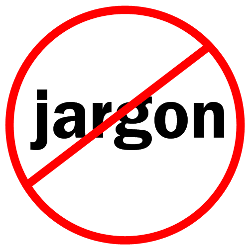Last week I wrote about the evils of using jargon. I got lots of responses. It’s clearly hard for people to get outside of their ‘insider’ mindset. When we use words at work daily, they begin to seem normal (even though we may’ve never used those words before). Before working at a social service agency, I never regularly used the words “client,” “youth,” “senior,” “programs,” “services,” “underserved,” or “managed care.” If you think these words are okay to use in your external communications, they’re really not. Later in this post I’ll point you to an article by Gail Perry that explains why. These are modern jargon; words that don’t cut it if you want to differentiate yourself, demonstrate impact and inspire investment.
Thanks to all of you who sent me your favorite jargon culprits. For those of you who may wish to avoid these words in your future marketing and fundraising materials, you’ll find a list of these offenders later in this post.
What it all seems to boil down to is communicating for understanding. Words you can use internally (or with funders, as per their requirements) should perhaps not be used externally. It takes a lot of awareness — and practice — to avoid falling into the jargon pit. I always ask myself:
1. Is there a more simple word?
2. Is there a word that has more impact?
3. Is there a word that’s more specific?
4. If I took this word out, would the meaning be just as clear? More clear?
5. Does this word unnecessarily (or stereotypically) categorize someone?
Words that bug folks:
attriting account-managed actioned back-end back of the envelope
bandwidth benchmark best practices capacity building change agent
community-based critical CRM cultivation dashboard development
disseminate distance travelled empower evidence-based front-end
going forward groundbreaking hard outcome impactful implement
innovative leverage pipeline proactive prospect regular giving
scoping soft outcomes state of-the-art stewardship successful
transparent unique utilize vital values-based volunteer
For another super list of jargon, check out this nifty
Philanthropy Jargon Generator. Besides being a lot of fun, it’s eye opening. It quickly becomes clear that when you use jargon – and it’s worse when you string jargon words together – you leave a lot of folks scratching their heads.
If head scratching is the emotional call-to-action you’re going for, then be my guest.
Jargon is not just acronyms and scientific language.
I recommend reading
The 3 Most Boring Words in Fundraising Appeals by Gail Perry. She explains why these words (which most of us have used all too often) – underserved; programs, and services — have little or no emotional impact.
Modern jargon is anything that is so overused and obtuse as to have become essentially meaningless.
Jargon puts people to sleep. And, surely, this is not your goal! For some other examples of slumber-inducing prose see
Jargon, Jargon We Got Jargon by Kristina LeRoux, which also includes a link to another list of commonly used clichés
and jargon.
Try to avoid anything that makes people hear/see “blah, blah, blah.”
THIS ABOVE ALL: Look for bang for the buck. Can the word stand on its own? Does the word scream for a response? Does the word make the reader feel something? Jargon is not compelling. Good writing should be compelling. Channel
Ernest Hemingway’s Top 5 Tips for Writing Well. Be brief, succinct and vigorous. Don’t use a word that makes the reader want to ask:
“What do you mean by that?” Avoiding jargon is really another way of saying:
Be a good writer.
How do you avoid using jargon? Do you have a system that works? Please share!





